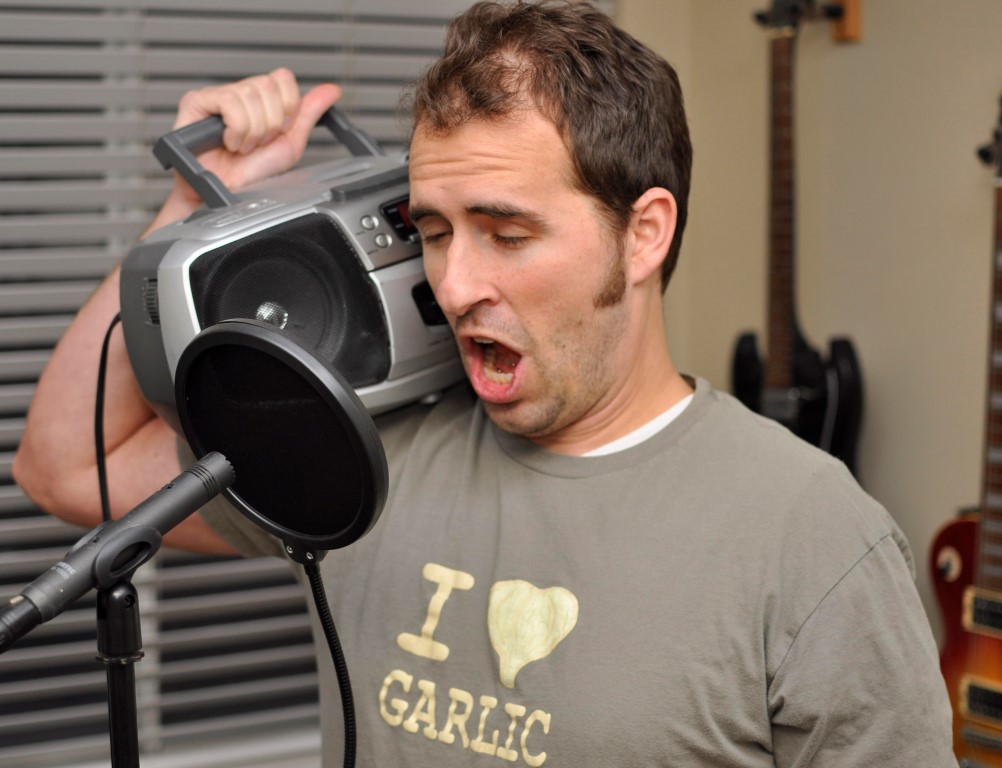
Tracking Without Headphones
It’s a well known fact that vocalists are an odd breed of people (I can say this because I now consider myself a vocalist, as proven below). Their water has the be the exact right brand and temperature, they generally sing best after a two hour yoga session, and they get sick ALL THE TIME, etc. But one of the things that is the absolute hardest things to deal with is getting the mix in their headphones just perfect. They can’t hear themselves, it’s not fluffy enough, the headphones make their voice sound orange. We’ve all heard these before.
Ok, to give a little credit to vocalists, it’s really hard to sing if you can’t hear yourself and the mix properly, and most people don’t practice singing with headphones on, so the whole setup is really out of their normal routine, which is why it’s hard for them (sorry, I mean us) to explain what they need.
Wouldn’t it be awesome to be able to track vocals without headphone without having horrendous amounts of bleed? What if you could just play the backing tracks through the monitors and ditch the headphones altogether? Well, you actually can. This simple trick will show you how you can get rid of the headphones and instead track with monitors without having unacceptable levels of track bleed.
How it’s Done
Step 1: Set up your monitors so that the vocalist can hear comfortably and sing along. You don’t have to worry about microphone bleed.
Step 2: Track the vocals, bleed and all.
Step 3: Make a new track and record just the monitors with no vocals. This track is pure bleed. That’s what we want.
Step 4: Invert the polarity on the bleed only track and play the two together. Most of the bleed should cancel out and you are left with the vocals only, with much less bleed.
Hands On Example
Here’s an example so you can hear how it works. I’m not normally one to brag, but yes, that’s me singing.
| Vox with Bleed |
| Bleed Only |
| Vox – Bleed |
You should notice right away how much bleed is reduced when combining the two tracks. It’s not completely gone, but it’s worlds better.
Caveats
It’s not perfect. This method certainly has some drawbacks, and it’s important to know what they are so you won’t be surprised when it comes time to mix.
You’ll notice from the example above that some of the high frequencies still bleed through. This is because even the tiniest of movement in the room creates massive phase delays at higher frequencies, which causes them to not cancel as well. Low frequencies are pretty much immune to this. So keep out any instruments from the source that you might not want in your final recording.
Make sure you pick your level correctly before you start tracking because if you change the level before recording the the background track, you may run into issues trying to get them to match in level.
A Few Tricks to Make it Work Even Better
Remove Some High Freqs
You can reduce the bleed of high frequencies by rolling off some of the high end in the monitors. You’ll obviously have to use your own judgement here to not overdo it and make it hard to sing to. Iin this example below, I pulled down the high end on the monitor EQ. Notice how much less bleed there is than the example above.
| Vox with Bleed |
| Bleed Only |
| Vox – Bleed |
Position the Mic
Point a cardioid mic away from the monitor. Since most cardioid microphones are better at rejecting high frequencies coming from behind, it makes sense that it might help to eliminate some of the high frequency bleed. Here’s a test I tried to show you the resluts of that.
Keep Acoustics the Same
When you record the background track, if possible, have the vocalist stand in front of the microphone without singing (or breathing too heavily). The small reflections that happen off the vocalists head and body have an effect on the background track, and removing that may change the acoustics more than you want.
Experiment
As always, try it out and experiment with different techniques to find a way that makes it work for you.
If you have any ideas to add to this, feel free to add to the discussion by commenting below.


great tip, thanks boz! (and thanks frankjcc for your interesting comment too).
FYI, U2’s Bono has been recording vocals like this for years and years…doesn’t like headphones…most recently, at Woodshed Recording in Malibu…
I’ve tried this years ago, the problem is the mess of multiple takes and edits, I concluded it wasn’t worth it.
placing the mic precisely in your listening position and flipping the phase on one speaker the create a null might work better, I think that’s what I tried years ago as well. I was told to tell my talent in a German voice, you vill vear the head phones, and you vill like it.
Yep, good point. If you line up your cuts so that there is no whitespace and no crossfades, it should be pretty simple, but that can be pretty limiting, especially if you have a lot of takes.
Excellent technique! Really hadn’t thought that one out before. Thanks.